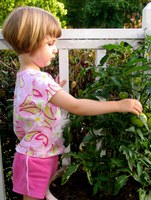Prairie Fare: More Dirt Might Promote Eating More Veggies
(Click the image below to view a high-resolution image that can be downloaded)
By Julie Garden-Robinson, Food and Nutrition Specialist
NDSU Extension Service
“What do you like about gardening?” I asked the group of children.
“Dirt!” one of them yelled.
“More dirt!” the group of 3- to 7-year-olds exclaimed in unison as they filled more gardening boxes.
Although my campus colleagues would prefer them to use the word “soil,” “more dirt” became a popular chant that evening as they filled the boxes, smoothed their gardens with a rake and prepared for planting.
The children are part of the Junior Master Gardener program coordinated by the NDSU Extension Service. The gardening activity was part of a summer religious education program for preschool and elementary children at a faith community.
The children talked about adding seeds to fertile soil, being patient and waiting for the seeds to sprout, taking care of the growing plants and harvesting the fruits of your labor.
You can learn a lot of life’s lessons by tending a garden.
With regular weeding, sunlight and water, our garden boxes will produce string beans, peas, lettuce, onions, radishes and other vegetables as the summer progresses.
After the hands-on gardening, I led the pack of joyful children from the garden to the piano for music class. Digging in dirt was a tough act to follow, so I distributed tambourines and other percussion instruments. My ears still are ringing.
Despite the musical accessories, gardening was the most popular activity. I’m OK with that.
Besides promoting increased physical activity for people of all ages, gardening activities can promote enhanced consumption of vegetables. Vegetables are the food group most likely to be lacking in the diets of children and adults.
A rainbow of fruits and vegetables not only adds color to your plate, but it also adds bountiful nutrition.
In most cases, the darker and brighter the hue, the more natural antioxidants, vitamins and minerals are present in the fruits and vegetables. That’s why having a salad with dark green spinach, romaine and/or kale adds more nutrition to your plate than a plateful of iceberg lettuce.
Vegetables and fruits are rich sources of vitamins, especially vitamins A and C. For example, carrots, leafy greens and sweet potatoes are good sources of vitamin (as beta carotene). Peppers and tomatoes are good sources of vitamin C.
To maintain the nutrition in your vegetables, be sure to remember your “three R’s”: reduce the amount of water used, reduce the cooking time and reduce the amount of exposed surface by limiting cutting, paring and shredding.
If you have a bumper crop of lettuce and radishes, this recipe provides a tasty way to add more to your menu. Radishes add some spark to your recipes.
Consider this tip: After harvesting radishes, be sure to remove their leafy tops before placing them in your refrigerator. Store unwashed radishes in an open or perforated plastic bag in a refrigerator drawer separate from the one in which you store fruits. Rinse radishes and trim their roots just before serving.
Be creative with your added salad ingredients. Add some dried or canned fruit, crunchy nuts and other flavorful ingredients. Add some leftover grilled chicken and/or hard-cooked eggs and you have a main dish. The recipe idea is courtesy of the University of Nebraska-Lincoln Extension in Lancaster County.
Visit http://www.ag.ndsu.edu/food for more information about preparing and preserving fruits and vegetables.
Loose-leaf Green Lettuce Salad With Apple Cider Vinegar Dressing
2 tsp. mild-flavored vegetable oil, such as canola oil or sunflower oil
1 tsp. apple cider vinegar
1/2 tsp. sugar
2 c. loose-leaf lettuce, rinsed thoroughly and drained
Optional add-ins: sliced radishes, finely sliced apples, mandarin oranges, cranberries, chopped pecans
Whisk oil, vinegar and sugar together in small bowl.
Makes one serving of dressing (about 1 Tbsp.), with 90 calories, 9 grams (g) of fat, 3 g of carbohydrate, 0 g of protein and 0 milligrams of sodium. The nutrition information of the overall salad will vary depending on your added ingredients.
(Julie Garden-Robinson, Ph.D., R.D., L.R.D., is a North Dakota State University Extension Service food and nutrition specialist and professor in the Department of Health, Nutrition and Exercise Sciences.)
NDSU Agriculture Communication – June 5, 2014
| Source: | Julie Garden-Robinson, (701) 231-7187, julie.garden-robinson@ndsu.edu |
|---|---|
| Editor: | Rich Mattern, (701) 231-6136, richard.mattern@ndsu.edu |


